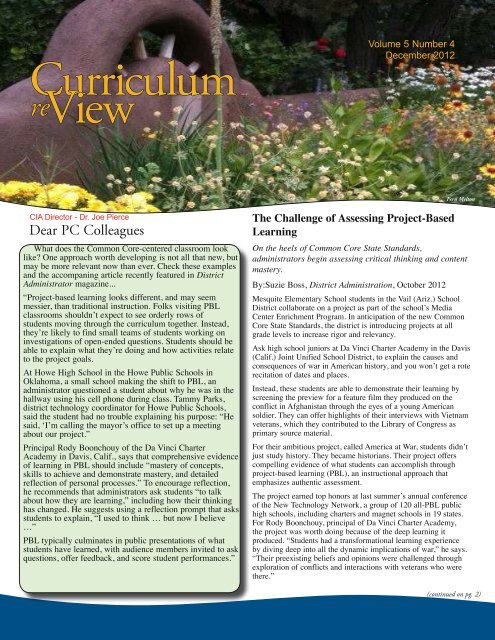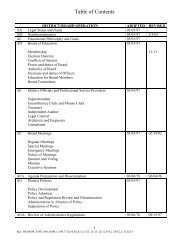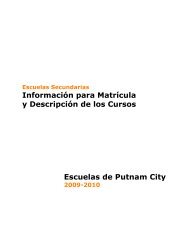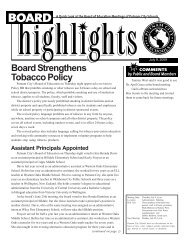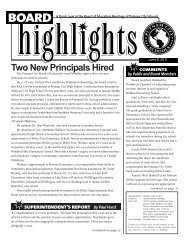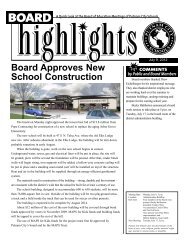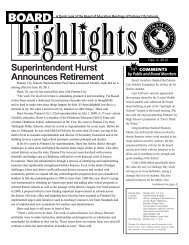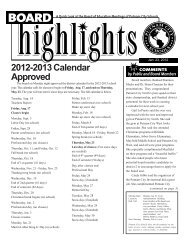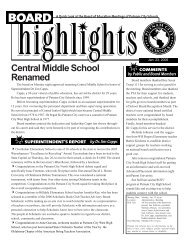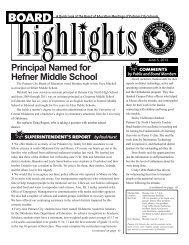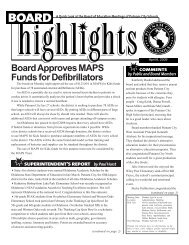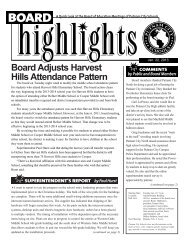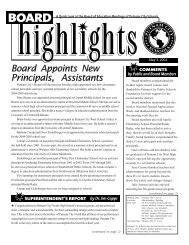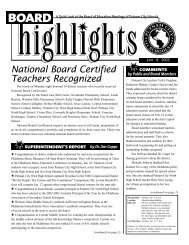December 2012 - Putnam City Schools
December 2012 - Putnam City Schools
December 2012 - Putnam City Schools
Create successful ePaper yourself
Turn your PDF publications into a flip-book with our unique Google optimized e-Paper software.
Curriculum<br />
re View<br />
Volume 5 Number 4<br />
<strong>December</strong> <strong>2012</strong><br />
Fern Melton<br />
CIA Director - Dr. Joe Pierce<br />
Dear PC Colleagues<br />
What does the Common Core-centered classroom look<br />
like? One approach worth developing is not all that new, but<br />
may be more relevant now than ever. Check these examples<br />
and the accompaning article recently featured in District<br />
Administrator magazine...<br />
“Project-based learning looks different, and may seem<br />
messier, than traditional instruction. Folks visiting PBL<br />
classrooms shouldn’t expect to see orderly rows of<br />
students moving through the curriculum together. Instead,<br />
they’re likely to find small teams of students working on<br />
investigations of open-ended questions. Students should be<br />
able to explain what they’re doing and how activities relate<br />
to the project goals.<br />
At Howe High School in the Howe Public <strong>Schools</strong> in<br />
Oklahoma, a small school making the shift to PBL, an<br />
administrator questioned a student about why he was in the<br />
hallway using his cell phone during class. Tammy Parks,<br />
district technology coordinator for Howe Public <strong>Schools</strong>,<br />
said the student had no trouble explaining his purpose: “He<br />
said, ‘I’m calling the mayor’s office to set up a meeting<br />
about our project.”<br />
Principal Rody Boonchouy of the Da Vinci Charter<br />
Academy in Davis, Calif., says that comprehensive evidence<br />
of learning in PBL should include “mastery of concepts,<br />
skills to achieve and demonstrate mastery, and detailed<br />
reflection of personal processes.” To encourage reflection,<br />
he recommends that administrators ask students “to talk<br />
about how they are learning,” including how their thinking<br />
has changed. He suggests using a reflection prompt that asks<br />
students to explain, “I used to think … but now I believe<br />
…”<br />
PBL typically culminates in public presentations of what<br />
students have learned, with audience members invited to ask<br />
questions, offer feedback, and score student performances.”<br />
The Challenge of Assessing Project-Based<br />
Learning<br />
On the heels of Common Core State Standards,<br />
administrators begin assessing critical thinking and content<br />
mastery.<br />
By:Suzie Boss, District Administration, October <strong>2012</strong><br />
Mesquite Elementary School students in the Vail (Ariz.) School<br />
District collaborate on a project as part of the school’s Media<br />
Center Enrichment Program. In anticipation of the new Common<br />
Core State Standards, the district is introducing projects at all<br />
grade levels to increase rigor and relevancy.<br />
Ask high school juniors at Da Vinci Charter Academy in the Davis<br />
(Calif.) Joint Unified School District, to explain the causes and<br />
consequences of war in American history, and you won’t get a rote<br />
recitation of dates and places.<br />
Instead, these students are able to demonstrate their learning by<br />
screening the preview for a feature film they produced on the<br />
conflict in Afghanistan through the eyes of a young American<br />
soldier. They can offer highlights of their interviews with Vietnam<br />
veterans, which they contributed to the Library of Congress as<br />
primary source material.<br />
For their ambitious project, called America at War, students didn’t<br />
just study history. They became historians. Their project offers<br />
compelling evidence of what students can accomplish through<br />
project-based learning (PBL), an instructional approach that<br />
emphasizes authentic assessment.<br />
The project earned top honors at last summer’s annual conference<br />
of the New Technology Network, a group of 120 all-PBL public<br />
high schools, including charters and magnet schools in 19 states.<br />
For Rody Boonchouy, principal of Da Vinci Charter Academy,<br />
the project was worth doing because of the deep learning it<br />
produced. “Students had a transformational learning experience<br />
by diving deep into all the dynamic implications of war,” he says.<br />
“Their preexisting beliefs and opinions were challenged through<br />
exploration of conflicts and interactions with veterans who were<br />
there.”<br />
(continued on pg. 2)
PBL as Driver of Change<br />
A third-grade class in Robious Elementary School in the<br />
Chesterfield County (Va.) Public <strong>Schools</strong> planted seeds and<br />
sprouts in the school community garden as a lesson in the plant<br />
unit.<br />
Although PBL has a long history in American education, dating<br />
to John Dewey and other early advocates of learning by doing,<br />
the project approach has gotten a second wind over the past<br />
decade as a strategy to engage diverse learners in rigorous<br />
learning.<br />
Early adopters include several public school networks, such as<br />
the New Tech schools, that leverage technology-infused PBL as a<br />
driver of school change. High Tech High, which has a deliberate<br />
focus on preparing high-poverty students for college, began<br />
with one school in Southern California and has expanded to 11<br />
public charter schools, elementary through high school, across<br />
San Diego County. Expeditionary Learning, another national<br />
network, reaches approximately 50,000 students in a variety<br />
of K12 public school settings. Its model emphasizes servicelearning<br />
and place-based projects that have strong connections to<br />
communities.<br />
PBL is expanding beyond these early adopters as districts<br />
consider strategies to help students meet the Common Core<br />
State Standards. In projects such as America at War, students<br />
are assessed based on what they produce or demonstrate rather<br />
than what they can recall for a test. “That application of learning<br />
is a higher need as we transition to the Common Core,” says<br />
Superintendent Calvin Baker of the Vail School District in<br />
Arizona. In anticipation of the new standards, his district is<br />
introducing projects at all grade levels, with the dual goals of<br />
increasing “rigor and relevancy.”<br />
Robious Middle School students in the Chesterfield County<br />
schools work with volunteers from the nearby James River Park<br />
system to learn about geocaching. During this activity, students<br />
incorporate multiple skills, like map reading and learning<br />
concepts of interconnectedness to the watershed.<br />
And Holly Bremerkamp, Acuity product manager at CTB/<br />
McGraw-Hill, adds that project-based learning and assessments<br />
are becoming increasingly important as there is a need to<br />
measure students’ abilities to think critically and collaborate with<br />
peers. Acuity is a comprehensive assessment-as-learning support<br />
system. “We’ve found that project-based learning methods—and<br />
the performance-based assessments that accompany them—<br />
are valuable in pushing students to demonstrate what they<br />
have learned in meaningful ways and valuable for teachers<br />
to understand how well students can apply their knowledge,”<br />
Bremerkamp says.<br />
Beyond the Bubble<br />
For administrators accustomed to the bubble tests of No Child<br />
Left Behind, the decision to implement PBL across a school<br />
system raises a challenging question: How should districts<br />
assess more open-ended learning that likely involves critical<br />
thinking and collaboration as well as content mastery? Rather<br />
than testing for recall of information, projects are better suited to<br />
performance-based assessments that ask students to demonstrate,<br />
apply and reflect on what they have learned.<br />
At Federal Hocking High School, part of Federal Hocking Local<br />
<strong>Schools</strong> in Stewart, Ohio, students end each semester with halfday<br />
performances of learning. Physical education students might<br />
be asked to design a personalized, hour-long exercise program,<br />
based on analysis of their own metabolic data, to work off the<br />
calories in a candy bar.<br />
“Students should be able to demonstrate their knowledge<br />
through application. That’s the ticket,” says George Wood, who<br />
is both superintendent of Federal Hocking Local <strong>Schools</strong> and<br />
principal of Federal Hocking High. He is also board president<br />
for the Coalition of Essential <strong>Schools</strong>, a nonprofit that promotes<br />
personalized learning and intellectual excellence in hundreds of<br />
member schools nationwide.<br />
Performance assessments like the ones Federal Hocking uses are<br />
still relatively rare in public schools, but they could soon become<br />
more commonplace. Two organizations have won federal<br />
contracts to develop next-generation assessment systems for<br />
English language arts and math. The Partnership for Assessment<br />
of Readiness for College and Career (PARCC) and the Smarter<br />
Balanced Assessment Consortium are developing measurement<br />
tools, with implementation expected by the 2014-2015 school<br />
year.<br />
Students at Da Vinci Charter Academy take part in a WWI<br />
project whereby each student team represents one nation in the<br />
war with role playing.<br />
Many observers are predicting parallels between the new<br />
assessments and the authentic assessment called for in PBL.<br />
PARCC describes its forthcoming assessments, for grades 3<br />
through high school, as “rich performance tasks” that will<br />
measure students’ readiness for entry-level college courses.<br />
Smarter Balanced recently released a sample of a pilot<br />
assessment task that asks students in grade 11 to “engage<br />
strategically in collaborative and independent inquiry to<br />
investigate/research topics, pose questions, and gather and<br />
present information.” That description prompted David Ross,<br />
director of teacher professional development for the Buck<br />
Institute for Education (BIE), a nonprofit resource for projectbased<br />
learning, to remark in a blog post, “Sounds like PBL to<br />
me.”<br />
Foot in Both Worlds<br />
Until the new assessments are rolled out, districts remain<br />
accountable to traditional state assessments, even if they’re<br />
shifting their instructional model to PBL. “We’re trying to stand<br />
with a foot in both worlds,” Baker says. “Everyone’s talking<br />
about what the new assessments will be like, but no one has<br />
shown them to us yet. When assessment changes, it’s a whole<br />
new game.” “We know that students can do more than what’s<br />
assessed by current state tests,” adds Allison Rowland, a former<br />
principal in California who is now an assessment specialist for<br />
New Tech Network.<br />
She welcomes the new generation of assessments, calling them<br />
“a means to drive students toward deeper learning and stronger<br />
preparation for college.” As administrators, she says, “we pay<br />
attention to what we measure. If we can shift the measurement<br />
so that students are better prepared and more engaged learners,<br />
then let’s do it.”<br />
Overcoming Anxiety<br />
Not all administrators are so eager for the changes ahead.<br />
“Leaders at the district and state levels are feeling some anxiety<br />
about moving to an assessment system that’s more open-ended,”<br />
acknowledges Rosanna Mucetti. A former principal, Mucetti is<br />
the director of district and state initiatives for BIE, which has<br />
been promoting best practices in PBL for 25 years.<br />
Under No Child Left Behind, districts across the country
have kept a laserlike focus on standardized test results.<br />
“Administrators have spent a decade getting up in front of their<br />
organizations, emphasizing data and meeting targets,” Mucetti<br />
says. “We’ve all been conditioned to pay close attention to that.<br />
The future horizon is not as crystal clear in terms of assessment.<br />
People are wondering, ‘What’s coming? And in the interim, what<br />
evidence should we focus on?’ There’s this tension.”<br />
Answers with One Model<br />
Students in the New Tech @ Ruston school, part of the New<br />
Technology Network, in the Lincoln Parish School Board in<br />
Louisiana take part in a Recyclable Roller Coasters project. They<br />
created a roller coaster from recyclable materials that could roll<br />
a marble unassisted for 20 seconds. In doing so, they learned<br />
about potential energy, kinetic energy, work and the law of<br />
conservation of energy.<br />
Answers are emerging from both practice and research. On the<br />
practice side, BIE emphasizes effective assessment strategies<br />
during its popular three-day professional development workshop,<br />
PBL 101, which it offers to teachers and instructional leaders in<br />
participating districts across the country. During the workshop,<br />
teachers develop rubrics to assess students’ final projects<br />
according to multiple measures. Students are assessed on mastery<br />
of significant academic content plus development of specific<br />
21st-century skills, such as collaboration or critical thinking.<br />
The BIE model also emphasizes using formative assessment<br />
strategies throughout a project to check on student understanding<br />
and to make just-in-time adjustments in instruction. (Samples<br />
of summative and formative tools are available at www.bie.org/<br />
tools/freebies.)<br />
On the research side, evidence of the value of PBL for rigorous<br />
coursework is emerging from an ongoing multiyear study called<br />
Knowledge in Action, designed by University of Washington<br />
researchers and implemented by Advanced Placement teachers<br />
in three states. Funded by an alliance that includes the George<br />
Lucas Educational Foundation and the Bill & Melinda Gates<br />
Foundation, the study shows that AP pass rates increased by<br />
as much as 30 percent during the 2011-<strong>2012</strong> school year when<br />
students engaged in a project-based curriculum rather than more<br />
traditional instruction. Researchers emphasize that projects need<br />
to be the “spine” of the curriculum rather than add-ons. (Read<br />
more at education.washington.edu/research/rtm_11/knowledgein-action.html.)<br />
Rethinking Assessments<br />
To paint a clearer picture of assessment in PBL, 20 teachers<br />
(still being selected as of early August) from New Tech schools<br />
in several states are starting a yearlong research project on<br />
performance assessment. Funded by the Hewlett Foundation’s<br />
Deeper Learning initiative, the national study will take place<br />
throughout the <strong>2012</strong>-2013 school year, with results expected by<br />
next summer. “We’re piloting performance assessments that are<br />
aligned to the Common Core and that will demonstrate students’<br />
readiness for college,” says New Tech Network’s Rowland.<br />
PBL emphasizes student choice and open-ended questions.<br />
“There’s an infinite number of projects you could do,” Rowland<br />
points out. “We want to make sure that PBL adds up to students<br />
actually being ready for college.”<br />
The Stanford University Center for Assessment, Learning<br />
and Equity researchers are consulting on the Deeper Learning<br />
research to determine which competencies to assess to ensure<br />
that high school graduates are indeed college-ready. Rowland<br />
says that assessments will be systematic and common across<br />
schools. Teachers at different schools might select different<br />
novels for language arts projects, for example, “but the rubrics<br />
and expectations of students will be the same.” Teachers will<br />
spend time examining student writing, video productions, and<br />
other project artifacts together as part of the yearlong study. That<br />
practice is already common in many PBL schools. High Tech<br />
High teachers, for example, use a protocol for examining student<br />
work together. “We do it to have a narrative of quality work,”<br />
High Tech High founder Larry Rosenstock explained during a<br />
recent conference presentation.<br />
Considering the Deeper Learning research project, a Webbased<br />
platform is being developed that will allow teachers from<br />
different states to upload student work samples. That means<br />
teachers at different locations “can assess student work together<br />
and calibrate around it,” Rowland says. “We’ll be looking not<br />
just within a school but across schools in our network.” The<br />
result, she continues, should be a sharper picture “of what it<br />
means to have high-quality, proficient student work.”<br />
Insights from these PBL early adopters “could create proof<br />
points of success” for the hundreds more school systems that are<br />
just starting to shift to projects, says BIE’s Mucetti. “They need<br />
to see how this would be replicable to their system.”<br />
Bold Leadership<br />
One district to watch is Chesterfield County (Va.) Public<br />
<strong>Schools</strong>, which serves 60,000 students. To update its strategic<br />
plan, the district spent the last two years conducting a series of<br />
community forums that engaged parents, students, teachers and<br />
business leaders, and that included guests such as an astronaut,<br />
an entrepreneur, a peace activist and a futurist. “They helped<br />
us paint a vision of what our students need for the future,” says<br />
Donna Dalton, the district’s chief academic officer.<br />
Chesterfield County’s strategic planning process pointed to PBL<br />
as the way to realize that vision, and now the district is preparing<br />
to introduce PBL across the entire system. It will start with<br />
six “trailblazer” schools that will become demonstration sites<br />
for PBL. The first wave of professional development will be<br />
provided by BIE next summer. The district plans to grow its own<br />
teacher-leaders for professional development by 2015 when PBL<br />
will reach all 62 schools. As the initiative expands, teachers will<br />
be involved in developing common rubrics and other assessment<br />
tools.<br />
Costs and Timeline<br />
The costs of shifting to project-based instruction and assessment<br />
are hard to quantify, but they primarily involve time and<br />
resources for professional development. “This requires a shift<br />
in focus in teaching,” says Rowland. “That involves teacher<br />
learning, which takes time.” If teachers are new to performance<br />
assessment, they may need to learn how to write rubrics and help<br />
students understand what high-quality project work looks like.<br />
To ensure that similar standards are applied from one classroom<br />
to the next, teachers also need time to examine student work<br />
together. “If you’re measuring something that’s not a bubble-in<br />
answer, it takes more conversation and calibration,” Rowland<br />
explains.<br />
Research presented at the American Educational Research<br />
Association’s annual meeting in April <strong>2012</strong> underscores the need<br />
for professional development to help teachers gain confidence<br />
with PBL methods. Using Project Based Learning to Teach<br />
21st-Century Skills: Findings from a Statewide Initiative<br />
reported results from a pioneering West Virginia initiative<br />
in which teachers became peer leaders in a statewide PBL<br />
Curriculum reView <strong>December</strong> <strong>2012</strong><br />
3
ollout. The study found that teachers who engaged in extended<br />
professional development have been able to implement projects<br />
“as a way to teach and assess 21st-century skills without<br />
sacrificing academic rigor.”<br />
In the Vail School District, common grade-level projects are<br />
being developed by lead teachers from all 17 schools. “Having<br />
common projects gives teachers a model of expectations [for<br />
quality work] and templates for project design they can use<br />
in their classroom,” explains Deborah Hedgepeth, assistant<br />
superintendent for instruction.<br />
Rather than bringing in outside experts, the Vail district is<br />
growing its own capacity to do PBL. The 20-plus teachers<br />
developing grade-level projects “are the experts who can work<br />
with their fellow teachers,” Hedgepeth says. She estimates<br />
that the cost of bringing her teachers together to spend four<br />
days intensively poring over the curriculum is about $60,000.<br />
“But that’s just a small piece of it,” she explains, adding that<br />
follow-up work at the local school level makes it difficult to put<br />
a price tag on the whole effort.<br />
For smaller districts, the challenge of developing new assessment<br />
systems can be traumatic, says Vail’s Baker, especially in tight<br />
budget times. His district digitizes its curricula and assessment<br />
materials and shares them for a fee on an award-winning site<br />
called Beyond Textbooks (beyondtextbooks.org). The site is used<br />
by 70 districts and individual charter schools across Arizona.<br />
“Our goal isn’t to make a profit, Baker says. “It’s to help other<br />
districts improve the academic achievement of their students and<br />
be ready for the sweeping changes ahead.”<br />
Suzie Boss is the author of Bringing Innovation to School and<br />
Reinventing Project-Based Learning. She is a member of the<br />
Buck Institute for Education’s national faculty.<br />
Secondary Language Arts - Ranee Staats<br />
Adolescent Literacy, Part 1: School-Wide<br />
Literacy Planning<br />
Posted on October 30, <strong>2012</strong> by Ed View 360, By Joan<br />
Sedita<br />
PART 1<br />
In recent years there has been a growing interest in<br />
adolescent literacy, especially as Americans become<br />
more concerned about the economic and civic health of<br />
the nation. Literacy skills are necessary more than ever<br />
to succeed in college and work, as well as to manage the<br />
everyday life demands of an increasingly more complex<br />
society and world economy. The best example of this focus<br />
is the tagline “college and career ready” from the Common<br />
Core State Standards (CCSS).<br />
More middle and high school leaders are beginning<br />
to acknowledge that they must develop a school-wide<br />
approach to teaching literacy skills that includes two tiers<br />
of instruction. The first tier is content literacy instruction<br />
for all students that is delivered in regular classes,<br />
including history, science, math, and English/language arts.<br />
The second tier is literacy instruction for struggling readers<br />
that is delivered partly in regular content classes and<br />
partly in intervention settings (including extended English/<br />
language arts blocks and individual/small-group settings).<br />
A school-wide approach to literacy instruction must<br />
involve all teachers in the delivery of reading and writing<br />
instruction, including content-area teachers and staff who<br />
work with special populations. This is a major tenet of the<br />
literacy CCSS. A successful school-wide plan must also<br />
have strong, committed leadership that provides ongoing<br />
support for literacy instruction.<br />
A Literacy Planning Model<br />
I have worked with numerous schools and districts to<br />
help develop literacy plans using a planning model that<br />
addresses six components:<br />
1. Establishment of a literacy planning team<br />
2. Assessment planning for screening, guiding instruction,<br />
and progress monitoring<br />
3. Literacy instruction in the content classroom<br />
4. Interventions for struggling readers that address phonics,<br />
word study, fluency, vocabulary, and comprehension skills<br />
5. Flexible scheduling to allow for grouping based on<br />
instructional needs<br />
6. Professional development planning<br />
A key first step is to assemble a literacy planning team<br />
that is representative of the major stakeholders who will<br />
have to implement the plan. Members of the team should<br />
include teachers of all subject areas, interventionists,<br />
parents, reading specialists, and administrators. It is<br />
important to recognize that literacy planning is a process,<br />
not an event. Like most school-wide initiatives, developing<br />
and executing a literacy plan will take time and sustained<br />
effort; literacy planning teams should be prepared for the<br />
process to take 1–3 years.<br />
Once a planning team is assembled, the first step is to<br />
take stock of what is already in place in relation to the<br />
six components. This includes gathering information that<br />
answers questions such as:<br />
What assessments are currently used to identify good and<br />
struggling readers?<br />
What assessments are used to identify specific needs of<br />
individual struggling readers? What reading instruction<br />
is already taking place in content classrooms, and what<br />
professional development do content teachers and<br />
others need in order to effectively address all reading<br />
components?<br />
What reading interventions and supplemental reading<br />
programs are currently offered for struggling readers?<br />
What information and professional development do the<br />
teachers of struggling readers need?<br />
Is the scheduling process flexible enough to accommodate<br />
different grouping patterns for struggling readers?<br />
After information has been collected to answer these<br />
questions, the planning team can set and prioritize goals<br />
and action steps for each of the six components. Some<br />
action steps are like low-hanging fruit—easy to accomplish<br />
quickly and with minimal expense. Other action steps will<br />
take longer to address. A concrete plan for addressing the<br />
Curriculum reView <strong>December</strong> <strong>2012</strong><br />
4
action steps throughout the coming year or two is essential<br />
to keep the process moving forward.<br />
A literacy assessment plan is key to successfully<br />
implementing a school-wide literacy plan. Screening<br />
literacy assessments provide the data to determine which<br />
students are struggling, while diagnostic assessments help<br />
determine why they struggle, and progress monitoring<br />
assessments determine if instruction is working in both<br />
content classrooms (Tier I) and with supplemental<br />
instruction (Tier II)<br />
The six planning components are interrelated. Action steps<br />
for one component need to be related to action steps for the<br />
other components. For example, decisions about both tiers<br />
of instruction should be based on assessment data, along<br />
with how to group students and schedule supplemental<br />
instruction. Plans for professional development should be<br />
made based on the needs of teachers and other members of<br />
the team.<br />
Middle and high school administrators must make<br />
the acquisition of literacy skills a priority and provide<br />
adequate time in the school schedule for reading and<br />
writing instruction. They must also be willing to use<br />
flexible grouping patterns when scheduling students in<br />
order to implement a two-tiered model for delivering<br />
reading instruction in both content classes and intervention<br />
settings. Professional development for content teachers and<br />
specialists is also essential.<br />
The time, effort, and expertise necessary to develop<br />
a school-wide plan for providing effective literacy<br />
instruction to all students present a challenge for most<br />
middle and high schools. The challenge is worth taking, as<br />
there is an urgent need to improve the reading, writing, and<br />
comprehension skills of these students.<br />
Elementary Language Arts - Melissa Ahlgrim<br />
Daily 5 and Writing<br />
We had a great turnout at the recent trainings for small<br />
group instruction. As you will recall, we spent quite a bit<br />
of this time talking about how to structure the classroom<br />
so that students are independently engaged in rigorous<br />
work while the teacher is working with a small group. One<br />
possible structure that was introduced was Daily 5.<br />
The Daily 5 is a structure for organizing literacy<br />
instruction. It is designed as a “catch and release” model—<br />
where the teacher catches the students in for short, targeted<br />
instruction as a whole group, then releases them back to<br />
practice the skills learned independently. When students<br />
are released to work, they are working through rotations<br />
like Read to Self, Read to Someone, Listen to Reading,<br />
Work on Writing, and Word Work. This cycle can be<br />
repeated as many times as needed, ending with some short<br />
closure at the end to discuss what we learned and how<br />
things went that day.<br />
One of the most essential components of Daily 5 is<br />
the explicit instruction of procedures. In both the workshop<br />
we offered and in the book, time was spent talking<br />
about how these procedures are introduced. The teacher<br />
introduces the activity (such as Read to Self) to students,<br />
discussing the PURPOSE of the activity. The students then<br />
help the teacher create an I-CHART (I=Independent) to<br />
list the procedures or expectations for the students. This is<br />
one step I am finding that we are often skipping, but it is<br />
a critical piece. Students (and teachers) need to have these<br />
procedures and expectations in writing, where they can<br />
be referred to often. When evaluating how the activity is<br />
going, students (and teachers) need to be able to look at<br />
these expectations to identify what is going well and what<br />
needs to be fixed. Teachers need to be able to point out<br />
specific actions to praise or correct so that students can<br />
understand the feedback being given.<br />
After identifying the purpose and creating an<br />
I-Chart, students need to be able to practice often. Having<br />
students model what the activity should, as well as should<br />
NOT, look like helps students understand exactly what<br />
is being expected of them. As they go off to practice, the<br />
need to be able to practice correctly to build their stamina.<br />
The phrase “practice makes perfect” is erroneous. It should<br />
be “perfect practice makes perfect”. Once students are<br />
practicing, as teachers we need to get out of the way for<br />
two reasons: (1) we don’t want to interrupt their work and<br />
(2) we don’t want them to be dependent on us to monitor<br />
their behavior. When we talk about getting out of the<br />
way, we are not saying to go grade papers, check e-mail,<br />
etc. This is the time to be hyper-alert to what students are<br />
doing without them being aware of what you are doing.<br />
This can be hard!<br />
So how long should we spend building this<br />
stamina? The general rule of thumb is that once K-1<br />
students have achieved 7-8 minutes, 2-3 students are at<br />
9-10 minutes, and 4-5 students are at 11-12 minutes, you<br />
are ready to introduce a new activity and keep things<br />
moving.<br />
Once procedures and structure are in place, don’t<br />
forget about content! The Daily 5 allows for how to<br />
structure our students, but what you teach is not specified.<br />
This is where our resources, such as Rigby, come in. When<br />
thinking about how our students are getting a balance of<br />
grade level content with working on their own level, think<br />
of it this way: during the whole group mini-lesson you<br />
are exposing students to grade level text and content. The<br />
small group time and centers are your opportunity to have<br />
students work at their instructional level on the content<br />
they need—whether it is reinforcing the content taught<br />
in the whole group, remediating foundational skills the<br />
student is lacking, or having them move beyond the grade<br />
level expectations.<br />
Curriculum reView <strong>December</strong> <strong>2012</strong><br />
5
Elementary Math - Paula Dyer<br />
Fluency<br />
The required fluency in the Common Core standards are:<br />
Kindergarten – Add/subtract within 5<br />
1st – Add/subtract within 10<br />
2nd – Add/subtract within 20 and Add/subtract within 100<br />
3rd – Multiply/Divide within 100 and Add/subtract within<br />
1000<br />
4th – Add/subtract within 1,000,000<br />
5th – multiply multi-digit whole numbers<br />
As we are using Common Core standards the fluencies<br />
look different as we progress through the grade levels.<br />
Fluency is defined as accuracy (correct answer), efficiency<br />
(a reasonable amount of steps), and flexibility (using<br />
strategies).<br />
Fluency is more than just a timed test where students<br />
are just rote memorizing numbers. It is more about how<br />
numbers work together.<br />
In Kindergarten fluency is an understanding and<br />
internalizing the relationships that exist between and<br />
among numbers. Seeing facts related to other facts (fact<br />
families), understanding what the commutative property is,<br />
seeing sub-parts within a number.<br />
With repeated experiences with many different types of<br />
concrete materials Kindergarten students will recognize<br />
that there are only particular sub-parts for each number.<br />
A Kindergarten teacher shared that she was doing another<br />
number talk with the number 5. She showed the students<br />
5 items, then took 2 away and asked the class how many<br />
were in the other hand. They had done this activity with 5<br />
items multiple times, sometimes taking 1 away, 2 away, 3<br />
away or none away, over and over. But on this particular<br />
day as some of the students responded you have 3 one of<br />
her students said, “Oh, I get it, 2 and 3 and 3 and 2 always<br />
makes 5.” This is fluency, understanding and internalizing<br />
that there are only particular sub-parts for each number.<br />
We must be diligent working on Number Sense, attaching<br />
number to quantity, recognizing numerals, writing<br />
numerals, seeing all the parts for each number, relating<br />
addition with subtraction (not making these separate<br />
entities). As we progress through elementary our students<br />
need to dig deep into the meanings of numbers and how<br />
they work, they need to find strategies that they can use so<br />
that they understand the meaning behind.<br />
Let your students struggle with problems and share with<br />
their peers how they solve the problem. Learning is more<br />
than listening.<br />
ELL- Dr. Jean Laine’<br />
This month’s article answers the following frequently<br />
asked questions:<br />
Is there a significant difference between the pull-out<br />
and push-in or pull-in ESL program models? How much<br />
time per week should ELL students spend in the ESL<br />
classroom?<br />
The pull-out English as a Second Language (ESL) program<br />
model is by far the most popular ESL instructional model<br />
in the world because it is easier to implement than the<br />
push-in one, especially, when resources are scarce. For<br />
instance, a school with a high number of ELL students<br />
may not be able to adequately meet the instructional needs<br />
of all the ELL students in the mainstream classroom with<br />
the push-in model. <strong>Schools</strong> would do better to pull out the<br />
students during specials so that ESL teachers can address<br />
language development in a meaningful way. Serving<br />
all ELL students is a must, and it is a federal mandate.<br />
Therefore, school districts do not have the luxury of<br />
picking and choosing which students to serve. All the<br />
students who are identified as limited English proficient<br />
should receive ESL instruction. School districts are<br />
required to monitor proficient students for two years to<br />
ensure that they are able to show real academic progress in<br />
mainstream classrooms.<br />
The ESL pull-out program model has been used in both<br />
elementary and secondary schools in the form of small<br />
flex groups or a class period. At the elementary level, it is<br />
recommended that English language learners (ELLs) spend<br />
30 minutes daily in the ESL classroom. When resources<br />
are scarce, school districts may opt for 30 minutes three<br />
to four days a week, but experts in linguistics suggest a<br />
daily meeting time in order to guarantee higher probably of<br />
academic success.<br />
As far as the pull-in or push-in model is concerned, it is<br />
used mainly at the elementary school settings. The ESL<br />
teacher goes into the regular classrooms to teach the ELL<br />
students. The content of the instruction is based on the<br />
objectives selected by the regular classroom teacher(s).<br />
The nature of this ESL instructional model is contentbased.<br />
This instructional model should be used when the<br />
ESL teacher involved is certified in elementary education,<br />
and he or she feels comfortable working collaboratively<br />
with the mainstream classroom teacher.<br />
Having examined ELL students’ performance data for<br />
six years in the <strong>Putnam</strong> <strong>City</strong> school district, I have not<br />
seen any significant difference between the pull-out and<br />
push-in models. Both models seem to work when they are<br />
implemented with fidelity. Principals should endeavor to<br />
support ESL teachers by ensuring that they have access<br />
to all the ELL students daily. The push-in model should<br />
be avoided if it means serving just a few of the total ELL<br />
students at the respective site.<br />
This is a good time in education.<br />
Curriculum reView <strong>December</strong> <strong>2012</strong><br />
6
The Arts - Jason Memoli<br />
A Commitment To Music In Education<br />
“We must move beyond art for art’s sake, to convey the<br />
importance of art for education’s sake.”<br />
—Dr. Charles fowler, strong arts, strong schools, 1996<br />
With the Journal for Learning Through Music, the New<br />
England Conservatory, through its Music Education<br />
department and Research Center for Learning Through<br />
Music, supports the belief that this is a critical time<br />
for music and the arts in schools. This new journal is<br />
intended to promote a national discourse focused on the<br />
extraordinary range of learning associated with music by<br />
providing a forum for the discussion of new perspectives<br />
on the essential role music can play in public school<br />
education. By providing a vehicle for joining evidence of<br />
the impact of 1) musical training on learning, 2) successful<br />
arts in education programs, and 3) positive change in<br />
schools due to music, the thinking and practices can be<br />
strengthened everywhere.<br />
The Journal is intended to speak to a broad audience:<br />
artists, teachers, educators, researchers, policy makers, and<br />
leaders of both cultural and arts-in-education organizations.<br />
It is hoped that members of that varied audience will<br />
find in this publication a place to describe efforts, share<br />
questions and findings, and engage in the debates that are<br />
necessary if the role of music in classrooms is to be more<br />
fully articulated and realized.<br />
In order to present some of the many perspectives on<br />
Learning Through Music, the Journal includes articles<br />
that, taken together, focus on the philosophy, research,<br />
and innovative program practices that address issues<br />
concerning the essential role of music in education reform.<br />
We want here to recognize the report, Champions of<br />
change: The impact of the arts on learning<br />
(Edward Fiske, 1999). It serves as a primary point of<br />
departure for the ongoing discourse about the role of music<br />
in the context of the arts education and school change<br />
efforts represented in this journal.<br />
The Journal also features interleaved “conversational<br />
interludes,” “photo essays,” and “provocative examples<br />
from the field,” meant to stimulate interconnections among<br />
the multiple perspectives from article to article. These<br />
“connectives” are intended to stimulate commentary<br />
that supports discourse between the authors and reports<br />
from the field. Accordingly, examples, imagery, and<br />
commentary emanating from ongoing action research at<br />
school sites are intended both to intro- duce each paper<br />
and to further the conversations implicit across articles.<br />
The first two issues of the Journal for Learning Through<br />
Music are intended to provide a focal point for the debate<br />
concerning the most appropriate and effective role of<br />
music as a resource and tool for arts efforts in public<br />
schools.<br />
THE FIRST ISSUE: AUGUST 2000<br />
This first issue is devoted largely to topics presented at<br />
the conference, “Why Integrate Music Throughout the<br />
Elementary School Curriculum?” hosted a year ago in<br />
Ipswich Massachusetts by the New England Conservatory.<br />
It explores various perspectives on this topic by including:<br />
• Commentary from philosophical and historical<br />
perspectives on music in the context of arts in education<br />
• Interviews, essays, and action research reports that reveal<br />
the practical experience of developing New England<br />
Conservatory’s new Learning Through Music Partnership<br />
<strong>Schools</strong><br />
• Research underway at the New England Conservatory<br />
that considers music and learning from qualitative and<br />
quantitative perspectives.<br />
THE SECOND ISSUE: WINTER, 2001<br />
A second issue, “Making Music Work for Public<br />
Education: Innovative Program Development and Research<br />
from a National Perspective,” is to be published in the<br />
winter of 2001. It will present findings from New England<br />
Conservatory’s national conference held on September 7-<br />
9, 2000. This issue will feature a broader range of topics,<br />
including keynote presentations, panel discussions, and<br />
roundtable responses which focus on the implications of<br />
music in education programs from a national perspective.<br />
We anticipate that the Journal for Learning Through<br />
Music will soon be available in electronic form. This<br />
format will allow authors to make better use of photographic<br />
evidence and documentation. It will also allow the<br />
presentation of video documentation of lessons, programs,<br />
interviews, and performances. <br />
REFERENCES<br />
Fiske, Edward B. (Ed.). (1999). Champions of change: The<br />
impact of the arts on learning. Arts Education Partnership<br />
and the President’s Committee on the Arts and the<br />
Humanities.<br />
Fowler, Charles. (1996). Strong arts, Strong <strong>Schools</strong>: The<br />
Promising Potential and Shortsighted Disregard of the<br />
Arts in American Schooling. New York: Oxford University<br />
Press.<br />
Curriculum reView <strong>December</strong> <strong>2012</strong><br />
7
Social Studies - Brenda Chapman<br />
NCHE’s History’s Habits of the Mind<br />
(Guidelines for Teaching History in <strong>Schools</strong>, Bradley Commission and NCHE)<br />
Courses in history, geography, and government should be designed to take students well beyond formal skills of critical<br />
thinking, to help them through their own active learning to:<br />
• Understand the significance of the past to their own lives, both private and public, and to their society.<br />
• Distinguish between the important and the inconsequential, to develop the “discriminating memory” needed for a<br />
discerning judgment in public and personal life.<br />
• Perceive past events and issues as people experienced them at the time, to develop historical empathy as opposed<br />
to present-mindedness.<br />
• Acquire at the same time a comprehension of diverse cultures and shared humanity.<br />
• Understand how things happen and how things change, how human intentions matter, but also how their<br />
consequences are shaped by the means of carrying them out, in a tangle of purpose and process.<br />
• Comprehend the interplay of change and continuity, and avoid assuming that either is somehow more natural, or<br />
more to be expected, than the other.<br />
• Prepare to live with uncertainties and exasperating, even perilous, unfinished business, realizing that not all<br />
problems have solutions.<br />
• Grasp the complexity of historical causation, respect particularity, and avoid excessively abstract generalizations.<br />
• Appreciate the often tentative nature of judgments about the past, and thereby avoid the temptation to seize upon<br />
particular “lessons” of history as a cure for present ills.<br />
• Recognize the importance of individuals who have made a difference in history, and the significance of personal<br />
character for both good and ill.<br />
• Appreciate the force of the non-rational, the irrational, and the accidental, in history and human affairs.<br />
• Understand the relationship between geography and history as a matrix of time and place, and as a context for<br />
events.<br />
• Read widely and critically in order to recognize the difference between fact and conjecture, between evidence<br />
Rubber and Glue by www.xkcd.com<br />
and assertion, and thereby frame useful questions<br />
Curriculum reView <strong>December</strong> <strong>2012</strong><br />
8
Science-Bob Melton<br />
Lesson learned! Next Generation Science<br />
Standards<br />
by Doug Haller, November 27th, <strong>2012</strong> http://smartblogs.com/<br />
education/<strong>2012</strong>/11/27/lesson-learned-next-generation-standardsbuild-challenges-encountered-1990s-douglas-f-haller-ed-m/<br />
The second public draft of the Next Generation Science<br />
Standards, developed by Achieve, is due for release before<br />
the new year. This draft represents step four in a ninestep<br />
process to update standards for K-12 sciences and<br />
engineering education. The nine-step process includes three<br />
public and two state review and comment periods before<br />
delivery of a final product. Once complete, states will opt<br />
to select or not select the NGSS for local implementation.<br />
The NGSS focus on science and engineering education<br />
whereas the Common Core State Standards initiative<br />
addresses math and English language arts education<br />
standards. The two independent efforts seek to achieve<br />
very similar goals: preparing U.S. students for academic<br />
and career success and global competitiveness in the 21st<br />
century. Each effort also seeks to provide educators and<br />
parents clear, cohesive and consistent guidelines that lead<br />
to a robust and meaningful education.<br />
The common core and NGSS initiatives benefited greatly<br />
from hard lessons learned during the development and<br />
implementation of the first generation of education<br />
standards disseminated in the 1990s. First and perhaps<br />
foremost, the current efforts actively sought state<br />
participation at the start of the process. National standards<br />
developed in the 1990s came across as top-down mandates.<br />
Next, the latest standards appear very concise and<br />
cohesive. In my area of expertise, science, the first draft<br />
NGSS were only 90 pages in length whereas the original<br />
NRC Standards and AAAS Benchmarks exceeded 200<br />
and 400 pages respectively. Thirdly, NGSS developers<br />
have anticipated the relationship between standards and<br />
assessment. The first generation of education standards<br />
led to a cycle of assessment development and standardized<br />
testing. The NGSS start with performance expectations<br />
that are aligned to scientific and engineering practices,<br />
crosscutting concepts, and disciplinary core ideas. Starting<br />
with how and what to assess, rather than what to teach,<br />
focuses on learning rather than teaching, placing the<br />
student at the center of the process.<br />
The Council of Chief State School Officers and the<br />
National Governors Association initiated the common core<br />
effort. These groups elected to focus on math and ELA.<br />
The “3 Rs” continue to heavily influence early elementary<br />
education — without a strong foundation in reading,<br />
writing and mathematics students struggle throughout<br />
grades K-12 regardless of the subject matter. The NGSS<br />
derive from a 400-plus page document known as the<br />
“Frameworks” developed by a team of scientists, engineers<br />
and experts in science and engineering education from<br />
the National Research Council. The Frameworks could be<br />
likened in the new standards process to the NRC Standards<br />
and AAAS Benchmarks of the 1990s. However, this time<br />
the Frameworks were written to inform the development of<br />
the NGSS rather than to act as the standards.<br />
“48 states and territories, the District of Columbia, and the<br />
Department of Defense Education Activity have adopted<br />
the Common Core State Standards and are in the process<br />
of implementing the standards locally.” — Council of<br />
Chief State School Officers.<br />
Let’s hope that the NGSS receive as much support as the<br />
common core standards. The NGSS effort includes 26<br />
states that likely will adopt the final product. The original<br />
science education standards were rarely adopted directly<br />
by states. Rather, states reviewed the Standards and<br />
Benchmarks, reinterpreting them into actionable items for<br />
teachers, a costly and time-consuming effort.<br />
Of course, with new standards in math, ELA and science<br />
and an overt directive to include engineering in grades<br />
K-12, educators, administrators, parents and education<br />
product developers should anticipate a whole new cycle of<br />
curriculum development and assessment design, as well as<br />
debates about accountability and effectiveness. Whether<br />
these are viewed as opportunities or as challenges,<br />
remember that at the heart of the discussion remains<br />
improving education for our youth.<br />
Doug Haller is the principal of Haller STEM Education<br />
Consulting. Haller is an education consultant specializing<br />
in strategic planning and market analysis to drive design,<br />
development and sales of niche education products for<br />
clients in the for-profit, nonprofit, and education and<br />
public outreach fields. His creative approach is based on<br />
years of practical experience as an educator, instructional<br />
designer and education consultant. Check out his blog,<br />
STEM Education: Inspire, Engage, Educate.<br />
Upcoming Science Olympiad Events<br />
PC West Science Olympiad Tournament<br />
(Divisions B and C)...................................<strong>December</strong> 15<br />
Norman Science Olympiad Tournament<br />
(Divisions B and C)....................................January 9<br />
<strong>Putnam</strong> <strong>City</strong> Elementary School (Division A) Science<br />
Olympiad Tournament, PC High ...............January 26<br />
<strong>Putnam</strong> <strong>City</strong> High School Science Olympiad Tournament<br />
(Divisions B and C)....................................February 2<br />
(tentative)<br />
Oklahoma State Science Olympiad Tournament<br />
(Divisions B and C) UCO.........................March 2<br />
Curriculum reView <strong>December</strong> <strong>2012</strong><br />
9
Oklahoma School Testing Program<br />
<strong>2012</strong> – 2013 Test Dates<br />
State Law Title 70 O.S. § 1210.508 and Federal Law H.R. 1<br />
Grade 3 Grade 4 Grade 5 Grade 6 Grade 7 Grade 8 Secondary Level<br />
End-of-Instruction (EOI)<br />
Oklahoma Core<br />
Curriculum Tests<br />
(OCCT)<br />
Mathematics and<br />
Reading<br />
Oklahoma Modified<br />
Alternate Assessment<br />
Program (OMAAP)<br />
Mathematics and<br />
Reading<br />
Oklahoma Core<br />
Curriculum Tests<br />
(OCCT)<br />
Mathematics and<br />
Reading<br />
Oklahoma Modified<br />
Alternate Assessment<br />
Program (OMAAP)<br />
Mathematics and<br />
Reading<br />
Oklahoma Core<br />
Curriculum Tests<br />
(OCCT)<br />
Writing; Reading,<br />
Mathematics,<br />
Science, and U.S.<br />
History<br />
Oklahoma Modified<br />
Alternate Assessment<br />
Program (OMAAP)<br />
Mathematics,<br />
Reading, and Science<br />
Oklahoma Core<br />
Curriculum Tests<br />
(OCCT)<br />
Mathematics and<br />
Reading<br />
Oklahoma Modified<br />
Alternate Assessment<br />
Program (OMAAP)<br />
Mathematics and<br />
Reading<br />
Oklahoma Core<br />
Curriculum Tests<br />
(OCCT)<br />
Mathematics,<br />
Reading, and<br />
Geography<br />
Oklahoma Modified<br />
Alternate Assessment<br />
Program (OMAAP)<br />
Mathematics and<br />
Reading<br />
Oklahoma Core<br />
Curriculum Tests<br />
(OCCT)<br />
Writing; Reading,<br />
Mathematics, Science,<br />
and U. S. History<br />
Oklahoma Modified<br />
Alternate Assessment<br />
Program (OMAAP)<br />
Mathematics, Reading,<br />
and Science<br />
Oklahoma Core Curriculum Tests (OCCT)<br />
ACE Algebra I, ACE Algebra II, ACE Biology I, ACE English II,<br />
ACE English III, ACE Geometry, and ACE U.S. History<br />
Oklahoma Modified Alternate Assessment Program (OMAAP)<br />
Algebra I, English II, Biology I, and U.S. History<br />
Multiple-Choice<br />
Testing Window:<br />
Wednesday,<br />
April 10, 2013 –<br />
Wednesday,<br />
April 24, 2013<br />
Multiple-Choice<br />
Testing Window:<br />
Wednesday,<br />
April 10, 2013 –<br />
Wednesday,<br />
April 24, 2013<br />
Writing Test Date:<br />
Wednesday, April 3<br />
and Thursday,<br />
April 4, 2013<br />
Multiple-Choice<br />
Testing Window:<br />
Wednesday,<br />
April 10, 2013 –<br />
Wednesday,<br />
April 24, 2013<br />
Multiple-Choice<br />
Testing Window:<br />
Wednesday,<br />
April 10, 2013 –<br />
Wednesday,<br />
April 24, 2013<br />
Online testing window<br />
for Grade 6<br />
Mathematics and<br />
Reading is extended<br />
through Friday, May 3,<br />
2013, for flexibility in<br />
scheduling computer<br />
time.<br />
Multiple-Choice<br />
Testing Window:<br />
Wednesday,<br />
April 10, 2013 –<br />
Wednesday,<br />
April 24, 2013<br />
Online testing<br />
window for Grade 7,<br />
Mathematics,<br />
Reading, and<br />
Geography is<br />
extended through<br />
Friday, May 3, 2013,<br />
for flexibility in<br />
scheduling computer<br />
time.<br />
Writing Test Date:<br />
Wednesday, April 3<br />
and Thursday, April 4,<br />
2013<br />
Multiple-Choice<br />
Testing Window:<br />
Wednesday,<br />
April 10, 2013 –<br />
Wednesday,<br />
April 24, 2013<br />
Online testing window<br />
for Grade 8<br />
Mathematics and<br />
Reading is extended<br />
through Friday, May3,<br />
2013, for flexibility in<br />
scheduling computer<br />
time.<br />
Winter:<br />
Optional Retest Window (OCCT online tests only)<br />
Monday, November 19 – Friday, November 30, <strong>2012</strong><br />
Multiple-Choice Testing Window<br />
Paper/pencil accommodation Monday, <strong>December</strong> 3, <strong>2012</strong> – Friday,<br />
<strong>December</strong> 21, <strong>2012</strong><br />
Online is extended through Friday, January 11, 2013<br />
Writing Test on Tuesday, <strong>December</strong> 11 and Wednesday, <strong>December</strong><br />
12, <strong>2012</strong><br />
Trimester:<br />
Multiple-Choice Testing Window<br />
Paper/pencil accommodation: Monday, January 21, 2013 – Friday,<br />
February 8, 2013<br />
Online is extended through Friday, February 15, 2013<br />
Writing Test on Tuesday, January 29 and Wednesday, January 30,<br />
2013.<br />
Spring:<br />
Optional Retest Window (OCCT online tests only)<br />
Monday, April 1, 2013 – Friday, April 12, 2013<br />
Multiple-Choice Testing Window<br />
Paper/pencil accommodation: Monday, April 15, 2013 – Friday, May<br />
3, 2013<br />
Online is extended through Friday, May 10, 2013<br />
Writing Test on Tuesday, April 23, and Wednesday, April 24, 2013<br />
Summer: Monday, June 3, 2013 through Friday, August 2, 2013<br />
Note: March 18-22, 2013, Suggested Coordinated Spring Break Week<br />
Curriculum reView <strong>December</strong> <strong>2012</strong><br />
10
Calendar of Meaningful Dates by www.xkcd.com<br />
Curriculum reView <strong>December</strong> <strong>2012</strong><br />
11


